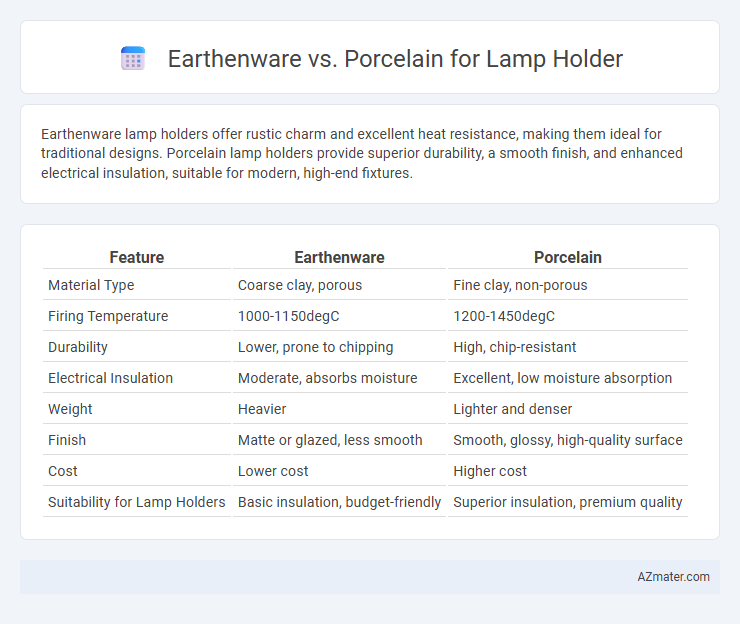Earthenware lamp holders offer rustic charm and excellent heat resistance, making them ideal for traditional designs. Porcelain lamp holders provide superior durability, a smooth finish, and enhanced electrical insulation, suitable for modern, high-end fixtures.
Table of Comparison
| Feature | Earthenware | Porcelain |
|---|---|---|
| Material Type | Coarse clay, porous | Fine clay, non-porous |
| Firing Temperature | 1000-1150degC | 1200-1450degC |
| Durability | Lower, prone to chipping | High, chip-resistant |
| Electrical Insulation | Moderate, absorbs moisture | Excellent, low moisture absorption |
| Weight | Heavier | Lighter and denser |
| Finish | Matte or glazed, less smooth | Smooth, glossy, high-quality surface |
| Cost | Lower cost | Higher cost |
| Suitability for Lamp Holders | Basic insulation, budget-friendly | Superior insulation, premium quality |
Introduction to Earthenware and Porcelain Lamp Holders
Earthenware lamp holders are crafted from porous clay fired at lower temperatures, offering a rustic and affordable option with natural insulation properties ideal for traditional lighting fixtures. Porcelain lamp holders, made from finely kaolin clay fired at high temperatures, provide a smooth, durable, and non-porous surface that withstands high heat and enhances electrical safety. Both materials serve distinct aesthetic and functional needs, with earthenware favored for vintage designs and porcelain preferred for modern, high-quality lighting solutions.
Material Composition: Earthenware vs Porcelain
Earthenware lamp holders are made from porous clay fired at lower temperatures, resulting in a coarser texture and increased fragility compared to porcelain. Porcelain lamp holders consist of kaolin and other refined clays fired at very high temperatures, creating a dense, smooth, and durable material ideal for electrical insulation. The difference in firing temperature and clay composition significantly impacts heat resistance and longevity, making porcelain preferable for high-performance lighting fixtures.
Durability and Strength Comparison
Earthenware lamp holders offer moderate durability with a porous and softer composition, making them more susceptible to chips and cracks under impact. Porcelain lamp holders possess superior strength due to their dense, vitrified structure, providing enhanced resistance to mechanical stress and thermal shock. This makes porcelain the preferred choice for lamp holders requiring long-lasting durability and robustness in various environmental conditions.
Heat Resistance and Electrical Safety
Earthenware lamp holders offer moderate heat resistance but can be more porous, potentially affecting electrical safety under high-temperature conditions, while porcelain provides superior heat resistance due to its dense, non-porous structure, ensuring reliable electrical insulation. Porcelain's higher dielectric strength makes it a preferred choice for lamp holders in environments with elevated temperature demands, reducing the risk of electrical breakdown. Choosing porcelain enhances durability and safety in high-heat applications, whereas earthenware may suit low-heat, decorative uses.
Aesthetic Differences and Design Options
Earthenware lamp holders offer a rustic, handcrafted appeal with warm, matte finishes and organic textures that complement traditional or bohemian decor styles. Porcelain lamp holders provide a sleek, refined look characterized by smooth, glossy surfaces and delicate translucency, making them ideal for modern, minimalist, or classic interiors. Design options in earthenware include earthy tones and irregular shapes, while porcelain allows for intricate detailing and a wider palette of subtle colors.
Cost and Availability
Earthenware lamp holders generally offer a lower cost due to simpler manufacturing processes and readily available raw materials, making them an economical choice for budget-conscious consumers. Porcelain lamp holders, although more expensive, provide higher durability and a refined finish, often found in specialty stores or premium suppliers. Availability of earthenware is typically broader in local markets, while porcelain may require purchasing from specialized outlets or online retailers.
Ease of Installation and Maintenance
Earthenware lamp holders offer easy installation due to their lightweight and user-friendly design, making them ideal for DIY projects. Porcelain lamp holders, while heavier and more fragile, provide a smooth finish that is simple to clean and resistant to heat and electrical wear. Maintenance for earthenware may require cautious handling to avoid chipping, whereas porcelain holds up better over time with minimal upkeep.
Suitability for Different Lighting Applications
Earthenware lamp holders provide robust durability and excellent insulation, making them ideal for rustic or industrial-style lighting that requires heat resistance and a sturdy base. Porcelain lamp holders offer a sleek, smooth finish with superior electrical insulation and heat tolerance, making them suitable for modern, decorative, or high-end lighting fixtures that demand both safety and aesthetic appeal. Choosing between earthenware and porcelain depends on factors like design preference, heat resistance needs, and the ambient environment of the lighting installation.
Environmental Impact and Sustainability
Earthenware lamp holders are made from natural clay materials with low energy consumption during firing, resulting in a smaller carbon footprint compared to porcelain. Porcelain requires higher kiln temperatures and more refined raw materials, leading to increased energy use and environmental impact. Choosing earthenware supports sustainability by utilizing abundant local resources and reducing emissions associated with production.
Which Lamp Holder Material is Best?
Porcelain lamp holders offer superior heat resistance and durability compared to earthenware, making them ideal for high-wattage bulbs and long-term use. Earthenware, though aesthetically pleasing with a rustic look, is more porous and less heat-resistant, potentially leading to faster wear and reduced safety. For optimal performance and safety in lamp holders, porcelain is the best material due to its non-porous surface and excellent electrical insulation properties.

Infographic: Earthenware vs Porcelain for Lamp Holder
 azmater.com
azmater.com